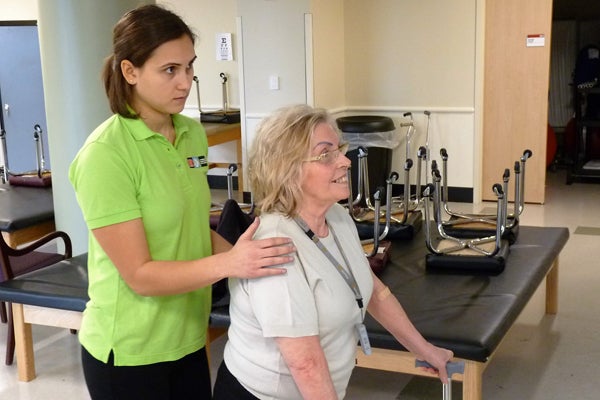Fun side of ‘serious games’ could aid in rehab
Listen
With the support of a physical therapy student
Specialized video games look to make physical therapy more engaging.
Before her stroke, Maria operated a butcher shop in her native Venezuela. But the event left her with limited use of her right arm and leg, forcing her to close the business and relocate to New Jersey, to live with her daughter.
As part of her ongoing physical therapy, the 77 year old, with gold-rimmed glasses and a metallic cane, attends a weekly clinic on Rutgers University’s Newark campus, where she has the opportunity to mix in both traditional exercises and a more cutting edge approach to rehab: serious video games.
“She’s slow to move, a little bit uncoordinated, and she presents with some of the movement problems that are very specific to what some of these games were developed for,” says Dr. Judy Deutsch, a professor in the Department of Rehabilitation and Movement Sciences at Rutgers University.
She watches as Maria works her way through a level of the game “V-Step,” which was built in-house by Deutsch and her team of coders. A bit like the arcade hit Dance Dance Revolution, players in V-Step follow a series of on-screen commands. When a blue block appears, Maria scores a point by using her left foot to virtually step on it. A red block means she uses her right foot, which presents more of a challenge.
As Maria makes her way through the level, she is walking, kicking or mimicking stair-climbing, the same movements she would do in traditional physical therapy.

Meghan Fosko, a first-year physical therapy student from Rutgers University, offers help to Maria, who is rehabilitating her right arm and leg with the help of a ‘serious game.’ (Todd Bookman/WHYY)
Unlike the arcade, though, there is no blaring music and no flashing lights.
“You’d think this game might be really boring for a young kid. It wasn’t designed for a young kid,” says Deutsch. “But I think it is more than not being boring, you want it to be meaningful. Because if exercise is just at the level of the muscle, and it is a repetitive nothing, nothing will transfer to real world actions. So you want it to be engaging your cognition as well as your movement,” says Deutsch.
There’s growing scientific evidence suggesting that these types of games may improve physical therapy outcomes by better engaging the user and increasing motivation, potentially leading to more repetitions and longer sessions. A concept Deutsch calls flow.
“In other words, when you play the game, you’re feeling it. You are in the zone.”
There was a lot of excitement about the rehab possibilities for the Nintendo Wii gaming system when it first came out in 2006. Off-the-shelf games, however, often prove too difficult or distracting for users with limited cognitive or physical abilities.
Deutsch’s V-Step is designed to let a physical therapist tweak settings to create a game-play that matches the user’s abilities. It uses the Microsoft Kinect motion sensor and camera, a $100 piece of hardware, to detect where the player’s body is in in the room. The low-cost technology is at the heart of the growing “serious game” movement.
“There had been similar technology I’d been working on 20 years ago, but it required $100,000 computers, with $50,000 systems. Now that we can get systems in the $100-200 range, it has opened it up to everybody,” says game developer and researcher Paul Diefenbach, who helps direct Drexel University’s RePlay Lab.
He’s developing his own suite of games, called enAble Games, aimed at children and adults with lifelong conditions, including cerebral palsy.
“This is a very underserved population that we are dealing with,” he says. “In addition to the physical and cognitive challenges that they have, they are very isolating conditions.”
To help these users connect with each other, the games will have leaderboards and online messaging systems. Like V-Step, players reach and kick at different floating objects, scoring points and trying to avoid obstacles, all while stretching muscles and getting in a cardiovascular workout.
Physical therapists could ‘prescribe’ a patient an hour’s worth of gaming a day, instead of other exercises they may not be all that inclined to do.
“A lot of what they have to do is at home, and if it is really something they don’t value or are not invested in, it is not going to happen,” says Dr. Maggie O’Neil, a pediatric physical therapist with three decades of experience.
O’Neil is working with Diefenbach to design and study these games. The Kinect system collects a wealth of data, not just about how many points the player scored, but also metrics as detailed as the degree of flex in a player’s elbow or knee. Tracking those measures over time could help a therapist measure progress, as well as let researchers determine if these serious games are superior to traditional physical therapy.
But there’s another metric that’s a little harder to predict. Can these games be commercially successful, or will they end up on gathering dust, unavailable to patients?
“If it was going to be just a university project, it would live and die in the university, as I’ve seen so many projects do,” says Paul Diefenbach. “So it was really important for me that we commercialize this, to actually get in the hands of the people that need it.”
WHYY is your source for fact-based, in-depth journalism and information. As a nonprofit organization, we rely on financial support from readers like you. Please give today.



